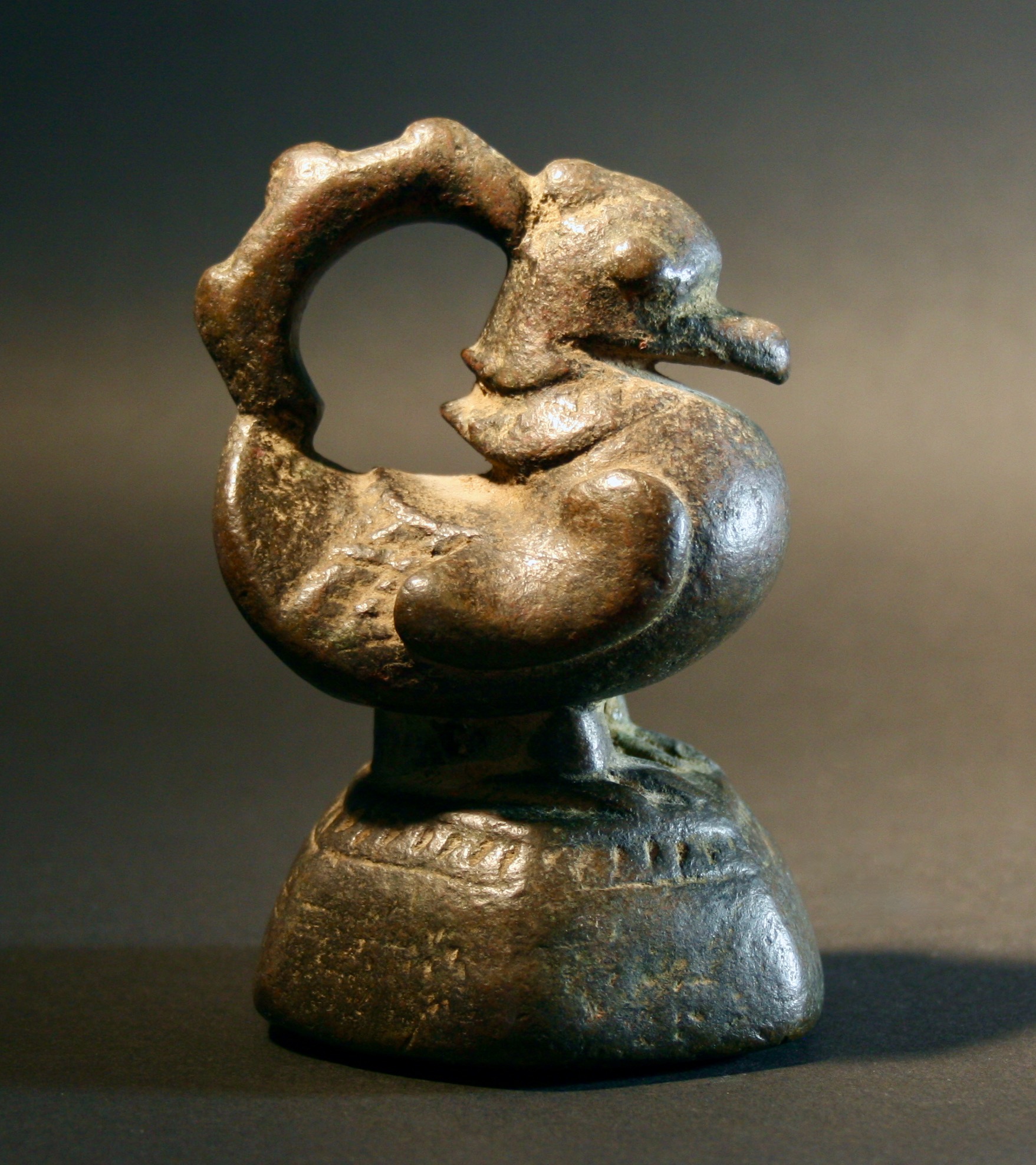

Title: 17th Century Antique Bronze Tibetan Duck Bird Opium Weight
Shipping: $29.00
Artist: N/A
Period: 17th Century
History: Ancient Art
Origin: Central Asia > China
Condition: N/A
Item Date: N/A
Item ID: 538
This is a truly remarkable 17th-century antique Tibetan bird duck opium weight, made of bronze. It stands at an impressive height of 4 3/8 inches and has a width of 3 inches. These ancient weights have become highly sought-after collectibles in today's market, thanks to their incredible beauty. The history of 17th-century antique Tibetan bird duck opium weights is an intriguing aspect of both Tibetan cultural heritage and the opium trade during that period. Here's an overview of their historical context: Origins and Purpose: Tibetan bird duck opium weights, often referred to simply as "Tibetan opium weights," were primarily used as tools for measuring opium. Opium was a valuable commodity and a significant part of the Tibetan economy during the 17th century. These weights helped traders and merchants standardize opium quantities, ensuring fair transactions. Artistic Excellence: What sets Tibetan opium weights apart is their exceptional craftsmanship and artistic design. Tibetan artisans took great pride in creating these miniature sculptures. Each weight was a work of art in itself, often depicting animals, mythological creatures, or intricate geometric patterns. These ornate designs served both functional and aesthetic purposes. Symbolism: The imagery on Tibetan opium weights often carried symbolic significance. Birds and ducks, for example, symbolized various aspects of Tibetan culture and spirituality. These weights could be seen as small expressions of Tibetan beliefs and values. Cultural Significance: Tibetan opium weights provide valuable insights into the culture and history of Tibet during the 17th century. They reflect the importance of trade and the opium economy in the region during that time. Additionally, they offer glimpses of Tibetan artistic traditions and the skill of Tibetan artisans. Collectibility: In modern times, Tibetan opium weights have become highly collectible due to their historical and artistic value. Collectors worldwide appreciate their beauty and the window they provide into Tibetan history. Many of these weights are now found in museums and private collections. Preservation: Efforts have been made to preserve and document these unique artifacts. Museums and cultural institutions work to safeguard these weights, recognizing their historical and artistic significance. In summary, 17th-century antique Tibetan bird duck opium weights are not only functional artifacts but also pieces of art that shed light on the opium trade and Tibetan culture during that period. Their intricate designs and historical relevance continue to captivate collectors and historians alike.
The collectibility of antique opium weights, particularly rare and intricately crafted ones, has gained significant attention in the world of art and antiquities. Here are some key points about the collectibility of these items: Historical Significance: Antique opium weights are tangible relics of a bygone era when opium played a pivotal role in trade and cultural practices. Collectors are drawn to them for their historical significance, as they provide insights into the opium trade, social customs, and craftsmanship of the past. Artistic Appeal: Opium weights are miniature works of art. Many of them feature intricate designs, often depicting animals, mythological figures, or cultural symbols. Collectors appreciate them for their aesthetic beauty and the craftsmanship of skilled artisans. Cultural Diversity: Opium weights were used in various regions of Asia, including China, Tibet, Southeast Asia, and the Indian subcontinent. Each region had its unique styles and designs, adding to the diversity of collectible opium weights. Collectors often seek to acquire pieces from different regions to explore this cultural diversity. Rare and Uncommon Varieties: Rarity significantly enhances the collectibility of opium weights. Certain designs, motifs, or materials used in crafting these weights are exceptionally rare. Collectors are particularly interested in acquiring these uncommon varieties, which can be considered prized possessions. Condition and Authenticity: Like any collectible, the condition and authenticity of opium weights are crucial factors. Collectors prefer pieces that are well-preserved, with minimal damage or wear. Provenance and documentation confirming authenticity also play a vital role in determining the value of these items. Market Demand: The demand for antique opium weights has grown over the years, driven by collectors, historians, and art enthusiasts. As a result, these items often command higher prices at auctions and in the collector's market. Ethical Considerations: It's important to note that the collecting and trade of opium-related artifacts can raise ethical questions, as opium has a history associated with addiction and social issues. Some collectors approach this niche market with sensitivity and a focus on preserving the historical and artistic aspects rather than glorifying the substance itself. In conclusion, the collectibility of antique opium weights is influenced by their historical, artistic, and cultural significance, as well as their rarity and condition. As with any collectible, the value of opium weights can vary widely depending on these factors, making them a fascinating and sought-after category for collectors.